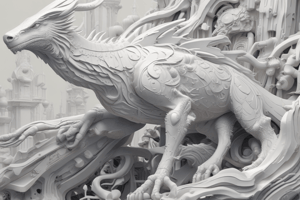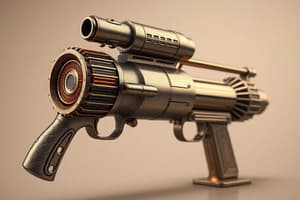Podcast
Questions and Answers
What is the main characteristic of additive materials technology?
What is the main characteristic of additive materials technology?
- It removes layers of material one at a time to build a solid part from top to bottom.
- It adds layers of material one at a time to build a solid part from bottom to top. (correct)
- It melts materials together to form a solid part.
- It cuts and shapes materials to form a solid part.
What is the primary purpose of rapid prototyping?
What is the primary purpose of rapid prototyping?
- To produce models and prototype parts for a wide range of applications. (correct)
- To generate complex shapes for fine arts exhibitions.
- To automatically construct physical objects using solid freeform fabrication.
- To manufacture production-quality parts in large numbers.
When did the first techniques for rapid prototyping become available?
When did the first techniques for rapid prototyping become available?
- Late 1980s (correct)
- Early 1990s
- Early 2000s
- Late 1970s
What is the process of rapid prototyping based on?
What is the process of rapid prototyping based on?
What is the main purpose of laying manufacturing technology using composite material layer by layer?
What is the main purpose of laying manufacturing technology using composite material layer by layer?
How are non-conventional methods different from traditional methods in terms of lead time for making a part?
How are non-conventional methods different from traditional methods in terms of lead time for making a part?
What is the primary purpose of 3D printing?
What is the primary purpose of 3D printing?
Which 3D printing material is suitable for creating realistic prototypes with excellent details and high accuracy?
Which 3D printing material is suitable for creating realistic prototypes with excellent details and high accuracy?
What advantage does 3D printing offer in terms of customization?
What advantage does 3D printing offer in terms of customization?
Which 3D printing material is suitable for creating photo-realistic full color models and sculptures?
Which 3D printing material is suitable for creating photo-realistic full color models and sculptures?
What does 3D printing eliminate the need for, resulting in lower fixed costs?
What does 3D printing eliminate the need for, resulting in lower fixed costs?
Which 3D printing material is suitable for engineering parts as strong as aluminum for the price of plastic?
Which 3D printing material is suitable for engineering parts as strong as aluminum for the price of plastic?
What advantage does 3D printing offer in terms of creating complex designs?
What advantage does 3D printing offer in terms of creating complex designs?
Which 3D printing material is suitable for simulating rubber with various levels of elasticity?
Which 3D printing material is suitable for simulating rubber with various levels of elasticity?
What advantage of 3D printing results from not needing to recoup upfront manufacturing costs?
What advantage of 3D printing results from not needing to recoup upfront manufacturing costs?
What material is used for creating functional prototypes and end-use parts from laser-sintered nylon?
What material is used for creating functional prototypes and end-use parts from laser-sintered nylon?
Additive technology builds a solid part from top to bottom.
Additive technology builds a solid part from top to bottom.
Rapid prototyping is the automatic construction of physical objects using solid freeform fabrication.
Rapid prototyping is the automatic construction of physical objects using solid freeform fabrication.
Rapid prototyping can only be used to produce models and prototype parts.
Rapid prototyping can only be used to produce models and prototype parts.
Rapid prototyping can be used to generate complex shapes for fine arts exhibitions.
Rapid prototyping can be used to generate complex shapes for fine arts exhibitions.
Laying manufacturing technology involves the removal of material.
Laying manufacturing technology involves the removal of material.
The first techniques for rapid prototyping became available in the late 1980s.
The first techniques for rapid prototyping became available in the late 1980s.
3D printing allows designers to create complex shapes and parts that cannot be produced by conventional manufacturing methods.
3D printing allows designers to create complex shapes and parts that cannot be produced by conventional manufacturing methods.
Each item created through 3D printing can be customized to meet a user’s specific needs without additional manufacturing costs.
Each item created through 3D printing can be customized to meet a user’s specific needs without additional manufacturing costs.
3D printing requires expensive tooling to create objects, leading to higher fixed costs compared to traditional manufacturing methods.
3D printing requires expensive tooling to create objects, leading to higher fixed costs compared to traditional manufacturing methods.
Rapid prototyping is a slower and riskier route to market compared to conventional manufacturing methods.
Rapid prototyping is a slower and riskier route to market compared to conventional manufacturing methods.
3D printing materials such as fiber-reinforced nylon are suitable for creating end-use parts as strong as aluminum for the price of plastic.
3D printing materials such as fiber-reinforced nylon are suitable for creating end-use parts as strong as aluminum for the price of plastic.
The primary purpose of rapid prototyping is to create functional prototypes and end-use parts from digital files.
The primary purpose of rapid prototyping is to create functional prototypes and end-use parts from digital files.
3D printing offers the advantage of creating full-color, photo-realistic models and sculptures using materials such as sandstone.
3D printing offers the advantage of creating full-color, photo-realistic models and sculptures using materials such as sandstone.
The process of rapid prototyping is based on laying manufacturing technology using composite material layer by layer.
The process of rapid prototyping is based on laying manufacturing technology using composite material layer by layer.
3D printing eliminates the need to recoup upfront manufacturing costs, resulting in a faster and less risky route to market.
3D printing eliminates the need to recoup upfront manufacturing costs, resulting in a faster and less risky route to market.
Traditional manufacturing methods require new molds for each part of each product, leading to higher fixed costs compared to 3D printing.
Traditional manufacturing methods require new molds for each part of each product, leading to higher fixed costs compared to 3D printing.
Flashcards are hidden until you start studying
Study Notes
Additive Materials Technology
- The main characteristic of additive materials technology is the layer-by-layer creation of solid parts from the bottom up.
Rapid Prototyping
- The primary purpose of rapid prototyping is to create functional prototypes and end-use parts from digital files.
- Rapid prototyping is the automatic construction of physical objects using solid freeform fabrication.
- The first techniques for rapid prototyping became available in the late 1980s.
- Rapid prototyping can be used to generate complex shapes, not only for models and prototype parts but also for fine arts exhibitions.
3D Printing
- 3D printing allows designers to create complex shapes and parts that cannot be produced by conventional manufacturing methods.
- 3D printing offers the advantage of customization, where each item created can be tailored to meet a user's specific needs without additional manufacturing costs.
- 3D printing eliminates the need to recoup upfront manufacturing costs, resulting in lower fixed costs and a faster, less risky route to market.
3D Printing Materials
- Fiber-reinforced nylon is suitable for creating end-use parts as strong as aluminum for the price of plastic.
- Sandstone is suitable for creating full-color, photo-realistic models and sculptures.
- A 3D printing material is available that can simulate rubber with various levels of elasticity.
Comparing 3D Printing and Traditional Manufacturing
- Non-conventional methods, such as 3D printing, have shorter lead times for making a part compared to traditional methods.
- Traditional manufacturing methods require new molds for each part of each product, leading to higher fixed costs compared to 3D printing.
Studying That Suits You
Use AI to generate personalized quizzes and flashcards to suit your learning preferences.




